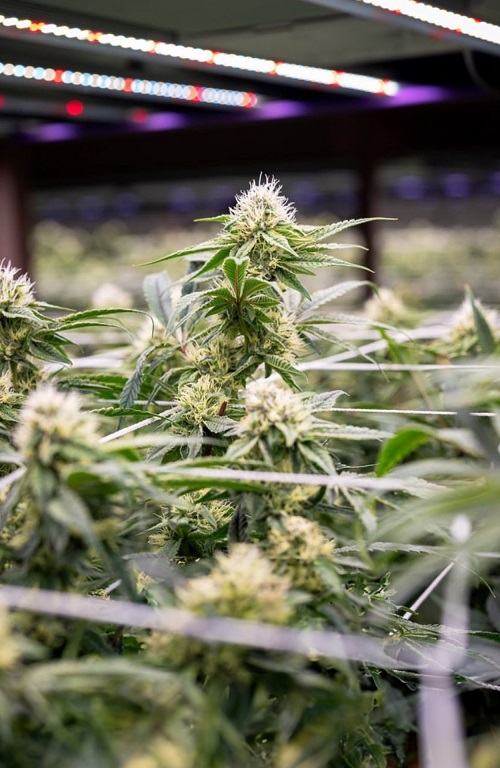
In the realm of indoor gardening, the spectrum of light that plants receive plays a pivotal role in their growth and development. When it comes to cultivating marijuana indoors, choosing the right LED (Light Emitting Diode) spectrum is crucial for maximizing yields and quality. Let’s delve into the factors that define the best LED spectrum for marijuana growing.
Understanding Light Spectrum and Plant Growth
Plants, including marijuana, utilize light primarily for photosynthesis, the process by which they convert light energy into chemical energy to fuel growth. Different wavelengths of light affect plants in varying ways:
- Blue Light (400-500 nm):Blue light is essential for vegetative growth, influencing leaf growth, root development, and overall plant structure.
- Red Light (600-700 nm):Red light is crucial for flowering and fruiting stages. It stimulates flowering hormones and enhances the production of essential oils, which contribute to bud formation and potency.
- Other Spectral Considerations:Apart from blue and red light, other wavelengths like far-red (700-800 nm) and ultraviolet (UV) light can also impact plant growth and secondary metabolite production, albeit to a lesser extent and with specific effects.
Choosing the Best LED Spectrum
When selecting an LED grow light for marijuana cultivation, consider the following factors to optimize plant growth:
- Full Spectrum vs. Specific Spectrum:LED grow lights come in full-spectrum (which mimic natural sunlight) or specific spectrum configurations tailored for either vegetative growth or flowering. Full-spectrum LEDs often include a balanced ratio of blue, red, and sometimes green and far-red light to cover all growth stages effectively.
- Stage-Specific Lighting:Some growers prefer using LED lights with adjustable spectrum settings. During the vegetative stage, higher proportions of blue light promote sturdy plant structure. As plants transition to the flowering stage, increasing the ratio of red light encourages robust flowering and resin production.
- Supplemental UV and Far-Red Light:Recent research suggests that supplementing with UVB (280-315 nm) light during specific phases can enhance cannabinoid production, potentially increasing the medicinal or recreational potency of marijuana.
- Intensity and Coverage:The intensity of light (measured in PPF – Photosynthetic Photon Flux ) and its uniform distribution across the canopy are critical. Ensure your chosen LED light provides adequate intensity and coverage for your growing space to avoid uneven growth or light stress.
The Impact of Spectrum on Yield and Quality
The right LED spectrum can significantly influence the yield, potency, and overall quality of marijuana. Research and practical experience indicate that:
- Yield:Optimizing the light spectrum can lead to higher yields per square meter due to improved photosynthetic efficiency and better flower development.
- Quality:The cannabinoid and terpene profile of marijuana plants can be enhanced by adjusting the light spectrum, potentially improving the flavor, aroma, and therapeutic effects.
Conclusion
In conclusion, while there isn’t a one-size-fits-all answer to the question of the best LED spectrum for marijuana growing, understanding the principles of light spectrum and plant physiology can guide you towards making informed choices. Whether you opt for a full-spectrum LED or one tailored to specific growth stages, ensuring adequate intensity and spectral balance is key to achieving optimal results in both yield and quality. As technology advances and our understanding of plant responses to light deepens, the future of LED spectrum optimization in indoor gardening, particularly for marijuana cultivation, promises even more exciting possibilities.








Легальные способы покупки диплома о среднем полном образовании
Купить диплом кандидата наук
kyc-diplom.com/diplom-kandidata-nauk.html
Как оказалось, купить диплом кандидата наук не так уж и сложно
диплом купить настоящий диплом купить настоящий .
Сколько стоит диплом высшего и среднего образования и как это происходит?
amurskij-dachnik.ru/forum/user/60617
Vibracion del motor
Sistemas de equilibrado: importante para el desempeño estable y eficiente de las máquinas.
En el entorno de la ciencia avanzada, donde la eficiencia y la seguridad del aparato son de suma relevancia, los equipos de calibración juegan un papel crucial. Estos sistemas especializados están creados para equilibrar y regular partes rotativas, ya sea en dispositivos manufacturera, vehículos de movilidad o incluso en aparatos domésticos.
Para los técnicos en reparación de aparatos y los profesionales, utilizar con aparatos de calibración es crucial para asegurar el operación fluido y estable de cualquier sistema móvil. Gracias a estas alternativas modernas avanzadas, es posible disminuir notablemente las movimientos, el estruendo y la esfuerzo sobre los rodamientos, mejorando la duración de partes valiosos.
También importante es el rol que cumplen los equipos de ajuste en la atención al cliente. El soporte técnico y el reparación continuo empleando estos aparatos posibilitan dar servicios de óptima estándar, aumentando la bienestar de los compradores.
Para los responsables de negocios, la aporte en estaciones de calibración y detectores puede ser esencial para optimizar la productividad y desempeño de sus equipos. Esto es particularmente relevante para los dueños de negocios que dirigen modestas y intermedias emprendimientos, donde cada detalle es relevante.
También, los aparatos de balanceo tienen una extensa uso en el área de la prevención y el control de excelencia. Habilitan localizar probables problemas, previniendo reparaciones caras y daños a los sistemas. Incluso, los datos recopilados de estos aparatos pueden aplicarse para optimizar sistemas y mejorar la presencia en motores de investigación.
Las áreas de aplicación de los dispositivos de ajuste cubren variadas áreas, desde la elaboración de vehículos de dos ruedas hasta el supervisión ecológico. No influye si se trata de extensas fabricaciones manufactureras o limitados espacios hogareños, los aparatos de ajuste son indispensables para garantizar un operación óptimo y sin riesgo de fallos.